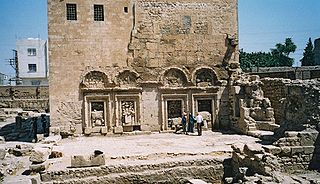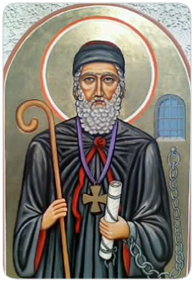Related Research Articles

Theodore of Mopsuestia was a Christian theologian, and Bishop of Mopsuestia from 392 to 428 AD. He is also known as Theodore of Antioch, from the place of his birth and presbyterate. He is the best known representative of the middle Antioch School of hermeneutics.

The School of Nisibis was an educational establishment in Nisibis. It was an important spiritual centre of the early Church of the East, and like the Academy of Gondishapur, it is sometimes referred to as the world's first university. The school had three primary departments teaching: theology, philosophy and medicine. Its most famous teacher was Narsai, formerly head of the School of Edessa.
Babai the Great was an early church father of the Church of the East. He set several of the foundational pillars of the Church, revived the monastic movement, and formulated its Christology in a systematic way. He served as a monastic visitor and coadjutor with Mar Aba as unofficial heads of the Church of the East after Catholicos Gregory until 628 AD, leaving a legacy of strong discipline and deep religious Orthodoxy. He is revered in the modern Assyrian Church of the East and Ancient Church of the East.

Henana of Adiabene was a Christian theologian, and headmaster of the School of Nisibis, the main theological center of the Church of the East (571–610).

Aba I or Mar Abba the Great was the Patriarch of the Church of the East at Seleucia-Ctesiphon from 540 to 552. He introduced to the church the anaphoras of Theodore of Mopsuestia and Nestorius beside the more ancient liturgical rite of Addai and Mari. Though his tenure as catholicos saw Christians in the region threatened during the Persian-Roman wars and attempts by both Sassanid Persian and Byzantine rulers to interfere with the governance of the church, his reign is reckoned a period of consolidation, and a synod he held in 544 as instrumental in unifying and strengthening the church. In 544, the Synod of Mar Aba I adopted the ordinances of the Council of Chalcedon. He is thought to have written and translated a number of religious works. After his death in February 552, the faithful carried his casket from his simple home across the Tigris to the monastery of Mar Pithyon.
Michael II was the Patriarch of Antioch and head of the Syriac Orthodox Church from 1292 until his death in 1312.
Ignatius Behnam Hadloyo was the Patriarch of Antioch and head of the Syriac Orthodox Church from 1445 until his death in 1454.
The Syro-Hexaplar version is the Syrian Aramaic (Syriac) translation of the Greek of the Septuagint as found in the fifth column of Origen's Hexapla. The translation was made by Bishop Paul of Tella at the monastery of the Enaton in Egypt around 617.
Barḥadbshabba ʿArbaya was a teacher, historian and biblical commentator of the Church of the East.
Julian I was the Patriarch of Antioch and head of the Syriac Orthodox Church from 591 until his death in 594/595. He is commemorated as a saint by the Syriac Orthodox Church.
Abū al-Faraj ʿAbd Allāh ibn al-Ṭayyib, known by the nisbaal-ʿIrāqī and in medieval Latin as Abulpharagius Abdalla Benattibus, was a prolific writer, priest and polymath of the Church of the East. He practised medicine in Baghdad and wrote in Arabic about medicine, canon law, theology and philosophy. His biblical exegesis remains the most influential written in Arabic and he was an important commentator on Galen and Aristotle. He also produced translations from Syriac into Arabic.
Cyrus of Edessa was a Syriac writer and teacher in the Church of the East. He was probably a native of Edessa. He studied at the school of Nisibis under Aba, the future patriarch, and then taught at the school of Seleucia-Ctesiphon, eventually rising to become its headmaster. He founded a monastery at Ḥirta sometime after the death of Aba (552).
Thomas of Edessa was a theologian of the Church of the East who wrote several works in Syriac, most of them lost.
Gabriel Arya, also called Gabriel Qaṭraya, was a biblical exegete who wrote in Syriac. The byname Qaṭraya indicates that he was a native of Beth Qaṭraye (Qatar). Arya, the Syriac for lion, is probably a nickname. He was a member of the Church of the East.
The School of Seleucia-Ctesiphon was a theological school of the Church of the East located in the western half of the city of Seleucia-Ctesiphon on the right bank of the Tigris. It was an independent Christian school, not attached to any particular church or monastery.
Ishoʿ of Merv was an East Syrian lexicographer of the 9th century AD. He was a native of Merv in the Abbasid Caliphate. He wrote a now lost glossary of Syriac words, which was used by Ishoʿ bar ʿAli in composing his own Syriac–Arabic glossary in the second half of the 9th century. According to the preface to Ishoʿ bar ʿAli's glossary, the work of Ishoʿ of Merv was poorly organized and differed at points from the glossary of Ḥunayn ibn Isḥāq. David Taylor sees Ishoʿ of Merv as augmenting the work of Ḥunayn, and Ishoʿ bar ʿAli in turn as augmenting him.
Gregory of Kashkar was the bishop of Kashkar and then from about 596 the metropolitan of Nisibis in the Church of the East. His hagiography treats him as a pivotal figure in the preservation of the church's distinctive theology.
Elishaʿ bar Quzbaye (fl. c. 450 – c. 510/530) was a hermeneut and apologist of the Church of the East. Active in Persia, he served as the second or third director of the school of Nisibis. He wrote extensively in Syriac, but only a few fragments of his works survive.
References
- ↑ Leonhard 2001 , p. 4.
- ↑ Leonhard 2001 , pp. 4–5.
- 1 2 Leonhard 2001 , p. 5.
- ↑ Guscin 2016 , p. 156.
- 1 2 3 Vauchez, Dobson & Lapidge 2000 , p. 739.
- 1 2 3 Leonhard 2001 , p. 8.
- ↑ Greenberg 2002 , p. 416.
- ↑ Van Rompay 2011.
- ↑ Leonhard 2001 , p. 17.
- ↑ Van den Eynde 1950–81.
- ↑ Gibson 2011.
- ↑ Fitzgerald 2010 , p. 341.
- ↑ Van Rompay 2011.
- ↑ Leonhard 2001 , p. 23.
- ↑ Leonhard 2001 , p. 12.
- ↑ Van Rompay 2011.
- ↑ Leonhard 2001 , p. 24.
- ↑ Russell 2009 , p. 60.
- ↑ Hill 1998, pp. 49–50.
- ↑ Leonhard 2001 , p. 8.
- ↑ Leonhard 2001 , p. 18.
- ↑ Leonhard 2001 , pp. 9–10.
- ↑ Leonhard 2001 , p. 11.
- ↑ Gibson 2011.
- ↑ Van den Eynde 1950–81.
- ↑ van Peursen 2011 , p. 145.
Bibliography
- Fitzgerald, John T. (2010). "Theodore of Mopsuestia on Paul's Letter to Philemon". In Tolmie, D. Francois (ed.). Philemon in Perspective: Interpreting a Pauline Letter. Berlin & New York: Walter de Gruyter. pp. 333–64.
- Gibson, Margaret (17 February 2011). The Commentaries of Isho'dad of Merv, Bishop of Hadatha (c. 850 AD): In Syriac and English. Cambridge University Press. ISBN 978-1-108-01906-4 . Retrieved 29 November 2012.
- Greenberg, Gillian (9 January 2002). Biblical Hebrew, Biblical Texts: Essays in Memory of Michael P. Weitzman. Continuum International Publishing Group. ISBN 978-1-84127-235-1 . Retrieved 29 November 2012.
- Guscin, Mark (2016). The Tradition of the Image of Edessa. Newcastle upon Tyne: Cambridge Scholars Publishing.
- Hill, C. E. (1998). "The Identity of John's Nathanael". Journal for the Study of the New Testament. 20 (67): 45–61. doi:10.1177/0142064x9802006703. S2CID 170347938.
- Leonhard, Clemens (2001). Ishodad of Merw's Exegesis of the Psalms 119 and 139–147: A Study of His Interpretation in the Light of the Syriac Translation of Theodore of Mopsuestia's Commentary. Louvain: Peeters.
- van Peursen, Wido (2011). "Ben Sira in the Syriac Tradition". In Rey, Jean-Sébastien; Joosten, Jan (eds.). The Texts and Versions of the Book of Ben Sira: Transmission and Interpretation. Leiden: Koninklijke Brill. pp. 143–66.
- Russell, Paul S. (2009). "The Psalms and Psalm 29 among Syrian Christians". In Hardy, Lowell K. (ed.). Psalm 29 through Time and Tradition. Cambridge: James Clarke & Co. pp. 52–68.
- Van den Eynde, Ceslas (1950–81). Commentaire d'Išo'dad de Merv sur l'Ancien Testament (in French). Louvain: Corpus Scriptorum Christianorum Orientalium.
- Van Rompay, Lucas (2011). "Ishoʿdad of Merv". In Brock, Sebastian P.; Butts, Aaron M.; Kiraz, George A.; Van Rompay, Lucas (eds.). Gorgias Encyclopedic Dictionary of the Syriac Heritage. Beth Mardutho / Gorgias Press . Retrieved 10 June 2019.
- Vauchez, André; Dobson, Richard; Lapidge, Michael (2000). Encyclopedia of the Middle Ages. Cerf. ISBN 978-1-57958-282-1 . Retrieved 29 November 2012.